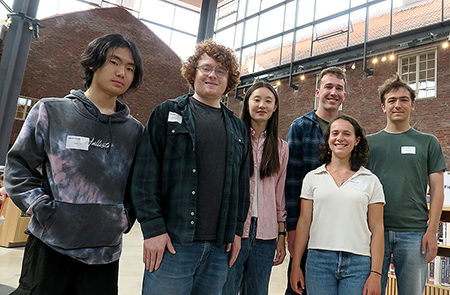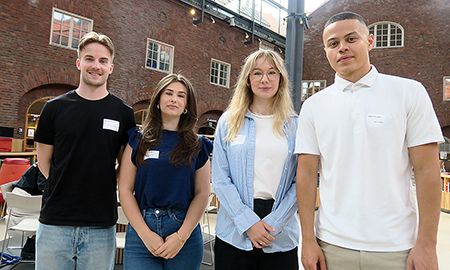KTH and UC Berkeley students switch places for eight-week research internship

A dozen students from Sweden and California switched places last week for summer research internships focused on digital transformation, kicking off a new exchange between KTH Royal Institute of Technology and University of California, Berkeley.
The addition of UC Berkeley to the annual Digital Futures Summer Research Internship (SRI) Program at KTH is one of the first steps toward closer collaboration between the two universities. Such exchanges are among the aims of an agreement KTH President Anders Söderholm signed one year earlier at the UC Berkeley campus.

After a June 5 welcome event at the KTH Library, students from UC Berkeley got busy with their KTH supervisors on projects in energy, intelligent tutoring systems, robotics, transportation and artificial intelligence. They will be working under the supervision of KTH researchers who are affiliated with Digital Futures, a cross-disciplinary research centre based at KTH which is dedicated to shaping an economically, environmental and socially sustainable society through digital transformation.
In the Bay Area, KTH students will also be working on generative AI, marine energy and hybrid vehicles under the supervision of research leaders at UC Berkeley.
Benefits of the programme
“The students will experience the life of a researcher in a different international setting,” says Anna Kiefer, who is international affairs adviser to the president of KTH. “It’s an opportunity for knowledge-sharing and learning, including how to build their networks in academia—and to understand how that works.”
Kiefer says UC Berkeley adds a new dimension to the internship program, which in turn presents a basis on which to build closer relations with a leading American university.
The two universities have a long history of cooperation to build upon.

“This exchange programme builds on years of research and academic collaboration between UC Berkeley and KTH,” says Larry Rohrbough, Executive Director of the C3.ai Digital Transformation Institute @ Berkeley. “We are excited for its launch and the research experience and cultural enrichment it will provide for students from both universities.”
Looking at emissions mitigation
One of the UC Berkeley students in the eight-week programme is Daisy Kerr, who was recommended by her supervisor, Professor Daniel Kammen, director of the Renewable and Appropriate Energy Laboratory (RAEL) at Berkeley. Freshly arrived in Sweden, Kerr enjoyed a visit to the National City Park adjacent to the KTH campus. “I’m impressed by how much green space there is, and with the air quality—I can physically feel it,” she says.
She’ll be researching the spillover effects of urban emissions mitigation efforts in Stockholm.
“I looked at the work the Energy department was doing here and I thought it was really interesting,” Kerr says. “I admire how Stockholm is handling sustainability, I thought it was an amazing opportunity to come over here and learn about how you do things.
“Hopefully I’ll contribute here and bring some lessons back to the U.S. and contribute there.”
Machine learning for education
KTH data science master’s student Nora Dunder has just settled in at International House on the Berkeley campus. “We get free meals every day and they’re really good,” she says.
Dunder will work with developing a scalable machine learning approach to translate Berkeley Professor Zach Pardos ’ open adaptive tutor (OATutor) system for students in Sweden who take a foundation year in preparation for university programmes.
“All the materials and content need to be translated into Swedish,” she says. “Not just word-for-word, but the cultural translation—incorporating how Swedish textbooks look, what kinds of problems we use in Sweden. It can be very different from what they use in the U.S.”
Getting acquainted with the lab environment and local area has been eye-opening in a number of ways for Dunder. She says it’s not only her introduction to lab work—it’s also her first visit to the U.S. “The campus is really nice, it’s so beautiful."
Besides the opportunity to add an impressive experience to her CV, Dunder says the internship offers a way to contribute to her interest in education. “This research project will hopefully make life easier for students in Sweden,” she says.
The Summer Research Program includes visits to Ericsson Imagine Studio, Xylem Water Solutions and Stockholm City Hall. The program also includes panels on life in industry and academia, as well as opportunities to meet with PhD students, workshops and social activities.
David Callahan
